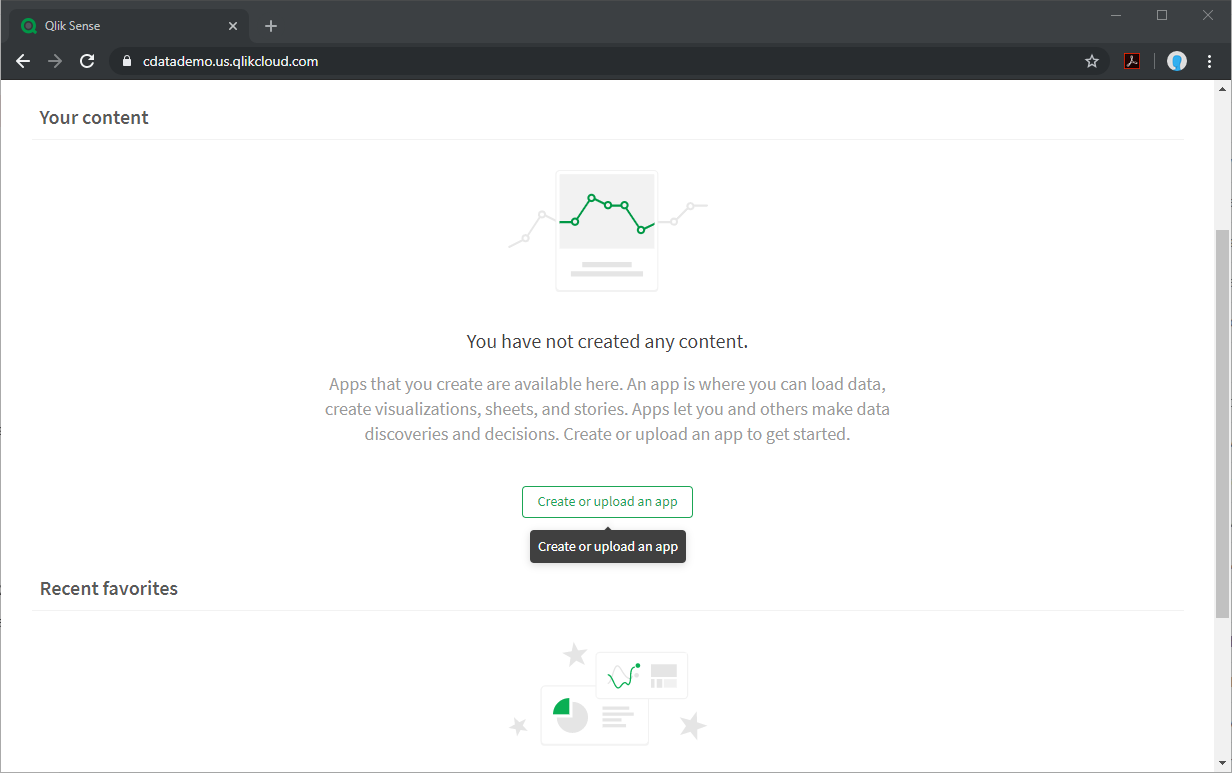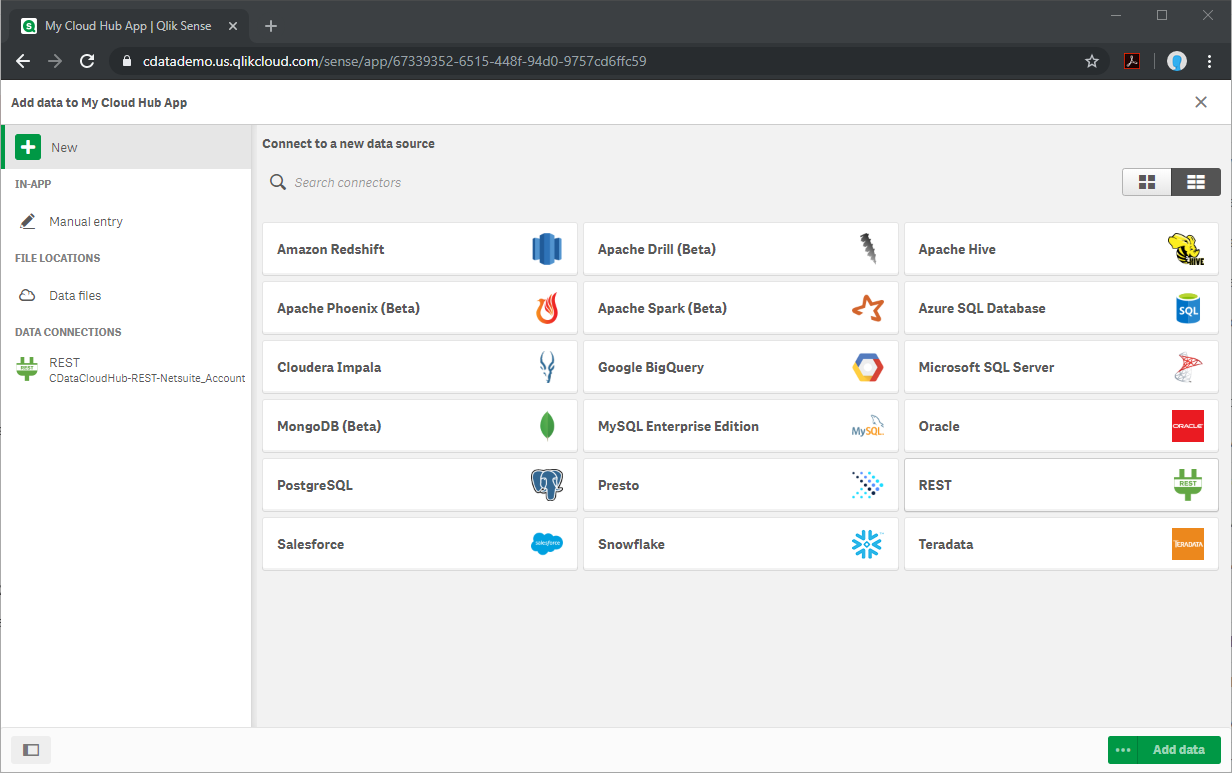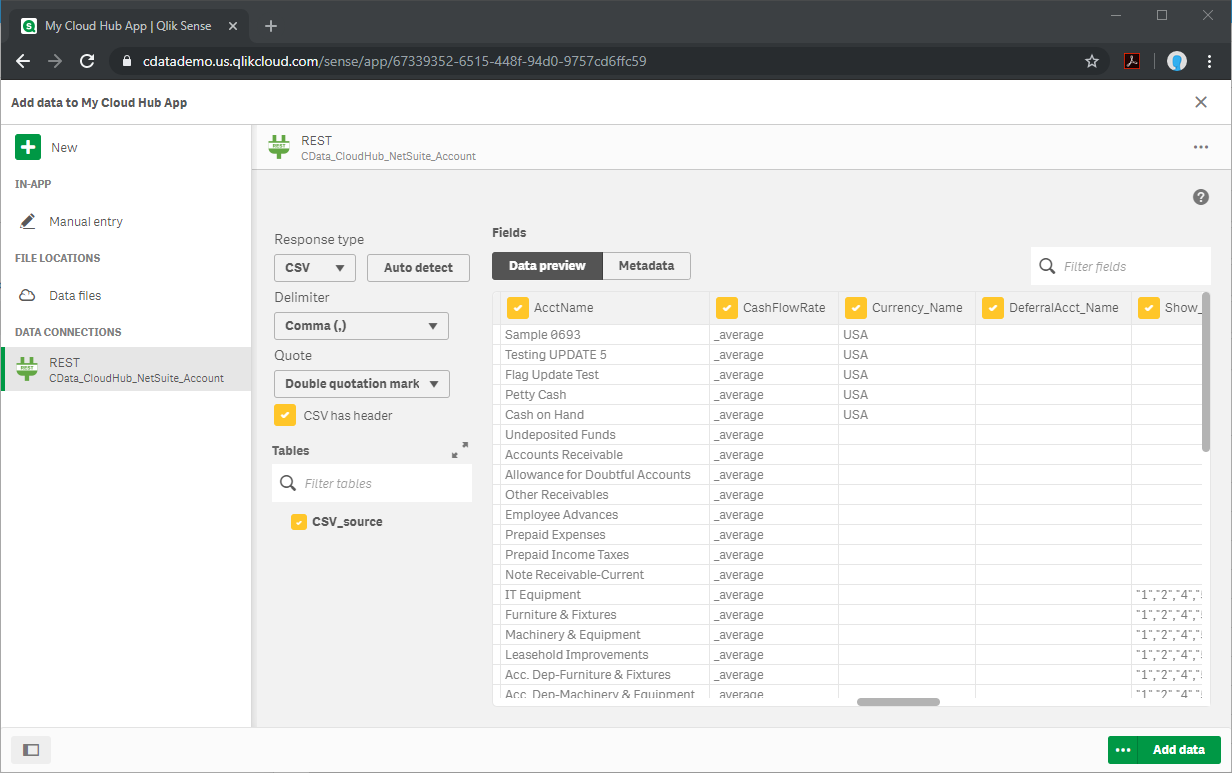Model Context Protocol (MCP) finally gives AI models a way to access the business data needed to make them really useful at work. CData MCP Servers have the depth and performance to make sure AI has access to all of the answers.
Try them now for free →Create Apps from SQL Analysis Services Data in Qlik Sense Cloud
Use the CData Connect Server to create an OData API for SQL Analysis Services data and build apps from live SQL Analysis Services data in Qlik Sense Cloud.
Qlik Sense Cloud allows you to create and share data visualizations and interact with information in new ways. The CData Connect Server creates a virtual database for SQL Analysis Services and can be used to generate an OData API (natively consumable in Qlik Sense Cloud) for SQL Analysis Services. By pairing Qlik Sense Cloud with the CData Connect Server, you get live connectivity to all of your SaaS and cloud-based Big Data and NoSQL sources — no need to migrate your data or write your integrations. Simply connect to Connect Server from Qlik Sense Cloud as you would any other REST service and get instant, live access to your SQL Analysis Services data.
In this article, we walk through two connections:
- Connecting to SQL Analysis Services in Connect Server
- Connecting to Connect Server from Qlik Sense Cloud to create a model and build a simple dashboard
Configure Connect Server to Connect to SQL Analysis Services
To connect to SQL Analysis Services data from Qlik Sense Cloud, you need to configure SQL Analysis Services access from your Connect Server instance. This means creating a user, connecting to SQL Analysis Services, adding OData endpoints, and (optionally) configuring CORS.
Add a Connect Server User
Create a Connect Server User to connect to SQL Analysis Services from Qlik Sense Cloud.
- Click Users -> Add
- Configure a User
![Creating a new user]()
- Click Save Changes and make note of the Authtoken for the new user
![Connect Server users]()
Connect to SQL Analysis Services from Connect Server
CData Connect Server uses a straightforward, point-and-click interface to connect to data sources and generate APIs.
- Open Connect Server and click Connections
![Adding a connection]()
- Select "SQL Analysis Services" from Available Data Sources
- Enter the necessary authentication properties to connect to SQL Analysis Services.
To connect, provide authentication and set the Url property to a valid SQL Server Analysis Services endpoint. You can connect to SQL Server Analysis Services instances hosted over HTTP with XMLA access. See the Microsoft documentation to configure HTTP access to SQL Server Analysis Services.
To secure connections and authenticate, set the corresponding connection properties, below. The data provider supports the major authentication schemes, including HTTP and Windows, as well as SSL/TLS.
-
HTTP Authentication
Set AuthScheme to "Basic" or "Digest" and set User and Password. Specify other authentication values in CustomHeaders.
-
Windows (NTLM)
Set the Windows User and Password and set AuthScheme to "NTLM".
-
Kerberos and Kerberos Delegation
To authenticate with Kerberos, set AuthScheme to NEGOTIATE. To use Kerberos delegation, set AuthScheme to KERBEROSDELEGATION. If needed, provide the User, Password, and KerberosSPN. By default, the data provider attempts to communicate with the SPN at the specified Url.
-
SSL/TLS:
By default, the data provider attempts to negotiate SSL/TLS by checking the server's certificate against the system's trusted certificate store. To specify another certificate, see the SSLServerCert property for the available formats.
You can then access any cube as a relational table: When you connect the data provider retrieves SSAS metadata and dynamically updates the table schemas. Instead of retrieving metadata every connection, you can set the CacheLocation property to automatically cache to a simple file-based store.
See the Getting Started section of the CData documentation, under Retrieving Analysis Services Data, to execute SQL-92 queries to the cubes.
![Configuring a connection (SQL Server is shown).]()
-
HTTP Authentication
- Click Save Changes
- Click Privileges -> Add, and add the new user (or an existing user) with the appropriate permissions (SELECT is all that is required for Reveal)
Add SQL Analysis Services OData Endpoints in Connect Server
After connecting to SQL Analysis Services, create OData Endpoint for the desired table(s).
- Click OData -> Tables -> Add Tables
- Select the SQL Analysis Services database
- Select the table(s) you wish to work with and click Next
![Selecting a Table (SQL Server is shown)]()
- (Optional) Edit the resource to select specific fields and more
- Save the settings
(Optional) Configure Cross-Origin Resource Sharing (CORS)
When accessing and connecting to multiple domains from an application such as Ajax, there is a possibility of violating the limitations of cross-site scripting. In that case, configure the CORS settings in OData -> Settings.
- Enable cross-origin resource sharing (CORS): ON
- Allow all domains without '*': ON
- Access-Control-Allow-Methods: GET, PUT, POST, OPTIONS
- Access-Control-Allow-Headers: Authorization
Save the changes to the settings.
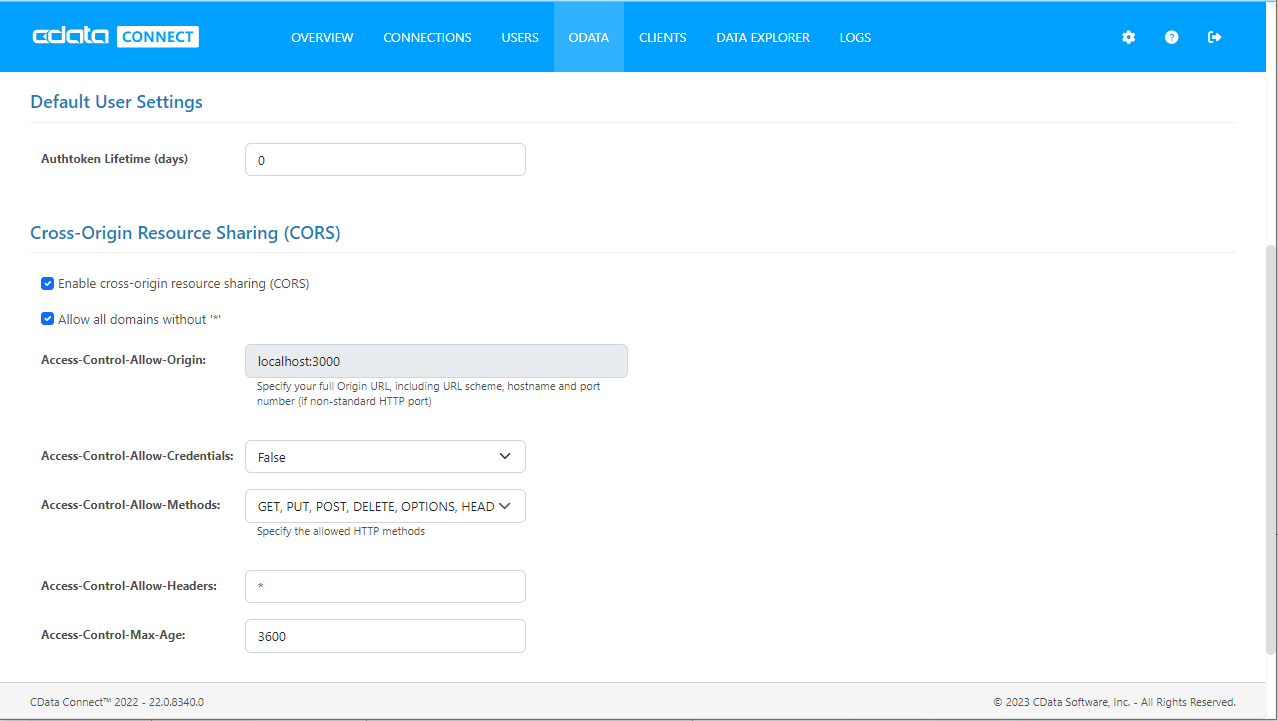
Create a Qlik Sense App from SQL Analysis Services Data
With the connection to SQL Analysis Services and OData endpoints created, we are ready to add SQL Analysis Services data to a Qlik Sense app for visualizations, analytics, reporting, and more.
Create a New App and Upload Data
- Log into your Qlik Sense instance and click the button to create a new app
![Creating a new app]()
- Name and configure the new app and click "Create"
- In the workspace, click to open the new app
- Click to add data from files and other sources
![Selecting a connector]()
- Select the REST connector and set the configuration properties. For the most part, you will use the default values, with the following exceptions:
- URL: Set this to the API endpoint for your SQL Analysis Services table, using the @CSV URL parameter to ensure a CSV response (i.e. CONNECT_SERVER_URL/api.rsc/SSAS_Adventure_Works?@CSV)
- Authentication Schema: Set this to "Basic"
- User Name: Set this to the user name you configured above
- Password: Set this to the Authtoken for the above user
- Click "Create" to query Connect Server for the SQL Analysis Services data
- Check "CSV has header" and under "Tables," select "CSV_source"
- Select columns and click "Add data"
![Adding data to the app (NetSuite is shown.)]()
Generate Insights or Customize Your App
With the data loaded into Qlik Sense, you are ready to begin discovering insights. Click "Generate insights" to let Qlik analyze your data. Otherwise, you can build custom visualizations, reports, and dashboards based on your SQL Analysis Services data.
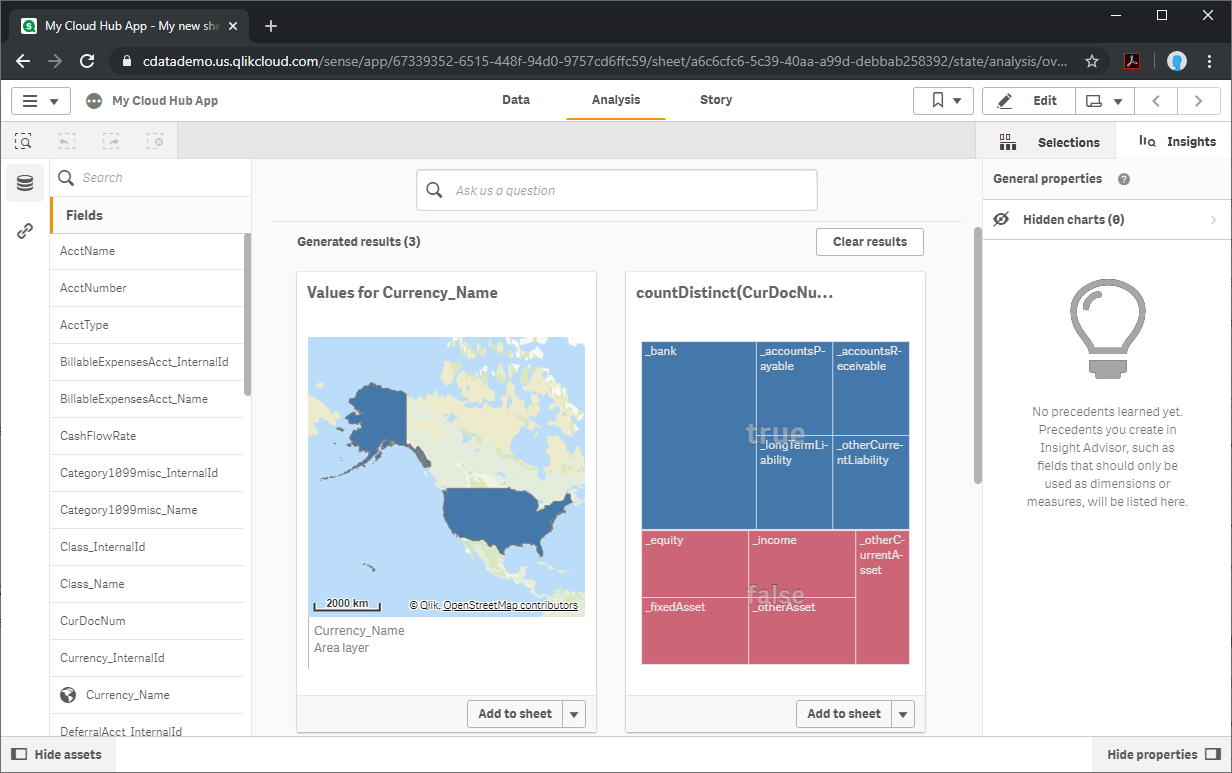
More Information & Free Trial
Now, you have created a simple but powerful dashboard from live SQL Analysis Services data. For more information on creating OData feeds from SQL Analysis Services (and more than 200 other data sources), visit the Connect Server page. Sign up for a free trial and start working with live SQL Analysis Services data in Qlik Sense Cloud.






